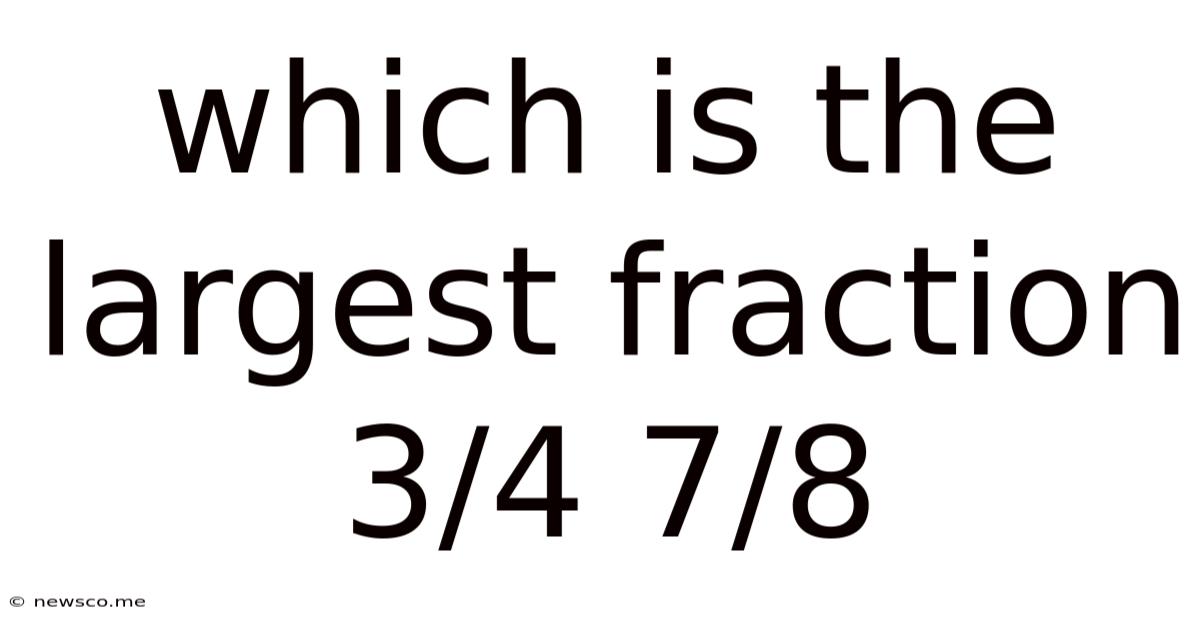Which Is The Largest Fraction 3/4 7/8
News Co
Apr 26, 2025 · 5 min read

Table of Contents
Which is the Largest Fraction: 3/4 or 7/8? A Deep Dive into Fraction Comparison
Determining the larger of two fractions might seem like a simple task, especially for those comfortable with basic arithmetic. However, understanding the underlying principles and developing effective comparison strategies are crucial for mastering fractions and tackling more complex mathematical concepts. This article delves deep into comparing fractions, focusing on the specific example of 3/4 and 7/8, while also providing broader strategies applicable to any fraction comparison.
Understanding Fractions: A Quick Refresher
Before diving into the comparison, let's briefly review the fundamentals of fractions. A fraction represents a part of a whole. It's expressed as a ratio of two numbers: the numerator (the top number) and the denominator (the bottom number). The numerator indicates how many parts you have, and the denominator indicates how many equal parts the whole is divided into.
For example, in the fraction 3/4, the numerator is 3 and the denominator is 4. This means we have 3 parts out of a total of 4 equal parts.
Method 1: Finding a Common Denominator
This is arguably the most common and widely understood method for comparing fractions. The core idea is to rewrite the fractions so they share the same denominator. This allows for a direct comparison of the numerators.
Steps:
-
Identify the denominators: In our case, the denominators are 4 and 8.
-
Find the least common multiple (LCM): The LCM is the smallest number that is a multiple of both denominators. In this case, the LCM of 4 and 8 is 8.
-
Convert the fractions:
- 3/4 can be converted to an equivalent fraction with a denominator of 8 by multiplying both the numerator and denominator by 2: (3 x 2) / (4 x 2) = 6/8
- 7/8 already has a denominator of 8, so it remains unchanged.
-
Compare the numerators: Now we have 6/8 and 7/8. Since 7 > 6, we conclude that 7/8 is the larger fraction.
Method 2: Using Decimal Equivalents
Converting fractions to decimals provides another effective way to compare them. This method is particularly useful when dealing with fractions that are difficult to convert to a common denominator.
Steps:
-
Convert each fraction to a decimal:
- 3/4 = 0.75
- 7/8 = 0.875
-
Compare the decimals: Since 0.875 > 0.75, we conclude that 7/8 is the larger fraction.
Method 3: Visual Representation
Visualizing fractions using diagrams, such as circles or rectangles divided into equal parts, can be a helpful method, especially for beginners.
Visualizing 3/4: Imagine a circle divided into four equal parts. Shade three of those parts.
Visualizing 7/8: Imagine another circle, this time divided into eight equal parts. Shade seven of those parts.
By visually comparing the shaded areas, it becomes evident that the shaded area representing 7/8 is larger than the shaded area representing 3/4. Therefore, 7/8 is the larger fraction.
Beyond 3/4 and 7/8: General Strategies for Fraction Comparison
The methods described above are not limited to comparing just 3/4 and 7/8. They can be applied to any pair of fractions. Here's a breakdown of strategies applicable to a broader range of fraction comparisons:
1. Cross-Multiplication: This is a quick method for comparing two fractions.
Steps:
- For fractions a/b and c/d, cross-multiply: a x d and b x c.
- If a x d > b x c, then a/b > c/d.
- If a x d < b x c, then a/b < c/d.
- If a x d = b x c, then a/b = c/d.
Let's apply this to 3/4 and 7/8:
- 3 x 8 = 24
- 4 x 7 = 28
Since 24 < 28, we conclude that 3/4 < 7/8. Therefore, 7/8 is the larger fraction.
2. Comparing to Benchmarks: Often, it's helpful to compare fractions to common benchmarks like 1/2, 1/4, 3/4, etc.
For instance, you immediately know that 3/4 is greater than 1/2, but less than 1. Similarly, 7/8 is greater than 1/2 and closer to 1 than 3/4.
3. Converting to Improper Fractions and Mixed Numbers: If you're dealing with mixed numbers (a whole number and a fraction), converting them to improper fractions (where the numerator is greater than or equal to the denominator) simplifies the comparison process.
Advanced Concepts and Applications
The ability to compare fractions is fundamental to many more advanced mathematical concepts:
- Algebra: Solving inequalities often involves comparing fractions.
- Calculus: Understanding the behavior of functions often requires comparing fractions representing slopes or rates of change.
- Probability: Many probability calculations involve comparing fractions representing probabilities of events.
Conclusion: Mastering Fraction Comparison
Comparing fractions is a crucial skill that builds a solid foundation for more advanced mathematical concepts. While the simple comparison of 3/4 and 7/8 might seem trivial, understanding the various methods – finding a common denominator, using decimal equivalents, visualizing, cross-multiplication, and comparing to benchmarks – equips you with versatile strategies applicable to a wide range of fraction comparisons. Mastering these techniques allows for confident problem-solving in various mathematical contexts. Remember to choose the method that best suits the fractions involved and your comfort level. With practice, you'll become proficient in comparing fractions quickly and accurately. This skill will not only improve your mathematical abilities but also enhance your problem-solving capabilities in diverse areas.
Latest Posts
Related Post
Thank you for visiting our website which covers about Which Is The Largest Fraction 3/4 7/8 . We hope the information provided has been useful to you. Feel free to contact us if you have any questions or need further assistance. See you next time and don't miss to bookmark.